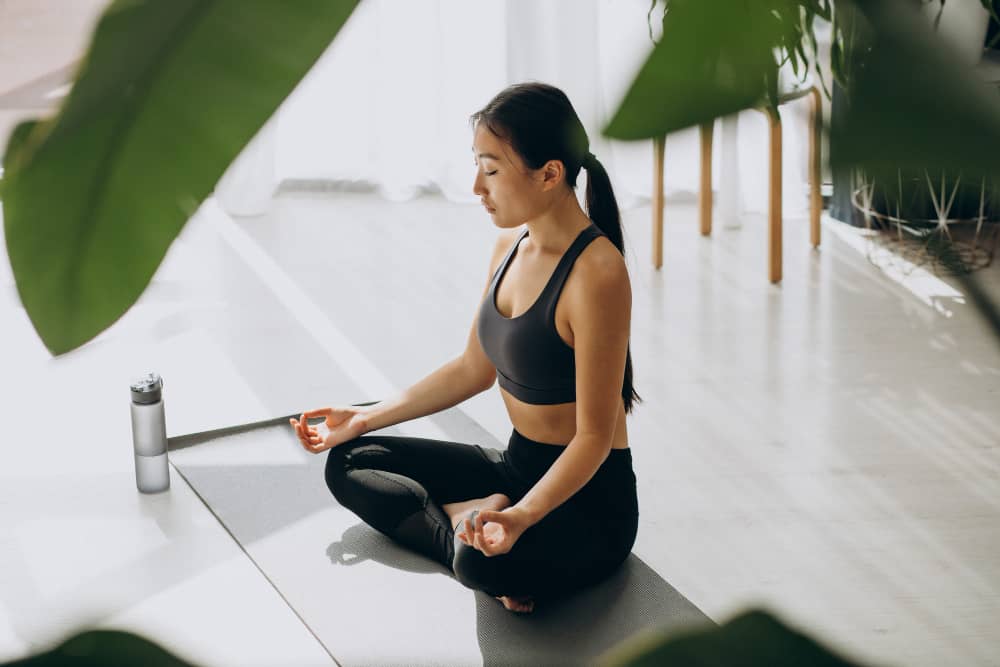Introduction
In the dynamics of modern life, health is not only related to physical condition but also to mental health. Mental and physical health closely intertwine, and both crucially shape an individual’s quality of life. Good mental health can influence physical health, and vice versa. In this perspective, meditation practices emerge as a powerful tool for enhancing overall health.
The Importance of Mental and Physical Health
Mental health refers to an individual’s state of mind, emotions, and feelings. It encompasses the ability to cope with stress, maintain emotional balance, and have a positive outlook on life. Meanwhile, physical health involves the physical condition of the body, including the cardiovascular system, muscle strength, and organ function.
Mental and physical health have significant impacts on daily life. Poor mental health can lead to excessive stress, anxiety, depression, and other psychological health issues. It can also affect eating patterns, sleep, and social interactions. On the other hand, mental stress and pressure can influence physical problems like heart disease, diabetes, and immune disorders.
The Role of Meditation in Enhancing Health
Meditation is an ancient practice involving inner focus and concentration to achieve a state of calm awareness and balance. Research has proven that meditation has positive effects on mental and physical health. Regular meditation practices can help reduce stress levels and anxiety, enhance inner peace, and improve the quality of sleep.
In terms of physical health, research has shown that meditation helps manage blood pressure, reduces inflammation in the body, and even enhances immune responses. Regular meditation practices can also help alleviate chronic pain sensations and improve overall feelings of physical health.
Thus, meditation plays a vital role in enhancing overall health. It is not just about relieving stress and improving mental balance but also about taking care of the body as a whole. Meditation practices provide an opportunity to reset the mind, connect with oneself, and cope with the demands of daily life more effectively.
What is Meditation?
Meditation is a spiritual and mental practice that has existed for centuries, used in various cultures and traditions. It involves the cultivation of concentration, awareness, and inner presence in order to achieve a state of calm and focused mind. Meditation can focus on various objects, such as breath, mantras, or inner observation.
Definition and Basic Concepts
Simply put, you can define meditation as a mental exercise that involves deep inner focus and concentration. It entails redirecting attention away from constantly swirling thoughts and bringing awareness to the present moment. In meditation, we learn to let passing thoughts come and go without becoming attached to them.
The basic concept of meditation involves the development of self-awareness and inner presence. This includes the ability to observe thoughts, feelings, and physical sensations without judgment or identification. In meditation, we learn to recognize the flow of thoughts without becoming entangled in every thought through emotional reactions or deep analysis.
Primary Goals of Meditation
The primary goals of meditation vary depending on the practice and the individual’s meditation objectives. However, some common goals of meditation include:
- Mindfulness: Meditation aims to achieve a quiet mind by reducing chaotic and confusing thought patterns. This helps create a more peaceful and stable inner state.
- Emotional Balance: Through observing feelings and emotions without becoming entangled in them, meditation helps us create distance between ourselves and our emotions, enabling us to respond more wisely and calmly.
- Improved Concentration: Meditation involves inner focus exercises that can enhance our ability to concentrate and pay attention in daily activities.
- Deep Awareness: Meditation helps develop deep awareness of oneself, one’s surroundings, and interactions with others. This helps us live more consciously and attentively.
- Enlightenment and Spiritual Development: Some traditions consider meditation a tool for gaining profound insight into the nature of reality or achieving spiritual enlightenment.
Read more : 6 Gym Tips for Beginners for More Effective Results
Benefits of Meditation for Mental Health

Recognizing meditation as a powerful tool for improving mental health.. This practice not only provides moments of tranquility in busy lives but also has a profound impact on the health of the mind and emotions.
Reducing Stress and Anxiety
One of the most well-known benefits of meditation is its ability to reduce stress and anxiety. In meditation, we focus our attention on the breath or another chosen object, redirecting our thoughts away from future worries or existing burdens of the mind. Through continuous practice, this can help reduce the levels of stress hormones like cortisol in our bodies, creating a deeper sense of relaxation.
Improving Focus and Concentration
Meditation practices involve exercises in concentration and inner focus. This has a positive impact on our ability to concentrate on daily tasks. By teaching us to redirect our thoughts away from distractions and develop concentration, meditation helps enhance our efficiency and productivity.
Enhancing Inner Peace
Inner peace is the ability to remain calm and serene in the face of life’s challenges.
Meditation teaches us to observe thoughts and emotions without getting carried away by them. This helps create distance between ourselves and our thoughts, allowing us to respond more wisely and mindfully.
By regularly practicing meditation, we can strengthen our ability to cope with everyday pressures, anxiety, and stress. This not only helps maintain emotional balance but also establishes a more stable foundation for overall mental health.
Benefits of Meditation for Physical Health
In addition to providing benefits for mental health, meditation also has significant positive effects on physical health. Regular meditation practices have demonstrated positive effects on various aspects of bodily health.
Managing Blood Pressure
One of the primary benefits of meditation for physical health is its ability to manage blood pressure. Through the relaxation induced by meditation, the body tends to experience a decrease in blood pressure, especially in individuals with high blood pressure. Regular meditation practices can help maintain blood pressure within a normal range and reduce the risk of cardiovascular issues.
Improving Sleep Quality
Meditation also has a positive impact on sleep quality. Individuals with insomnia or difficulty sleeping often find benefits from meditation as it can help reduce restless thoughts and stress that can disrupt sleep. Meditation can create a calm and relaxed mental state, allowing for more restful and restorative sleep.
Reducing Pain Sensations
Certain forms of meditation have been proven to help reduce chronic pain sensations. In these practices, inner focus is used to change one’s perception of pain, thus reducing its intensity and its impact on daily life. Meditation can also help improve tolerance to pain sensations, enabling individuals to manage them more effectively.
Preparation Before Starting Meditation

Preparation before beginning meditation is an important step to ensure a more meaningful and effective meditation experience. There are several things to consider before you start practicing meditation.
Choosing the Right Time and Place
Selecting the right time is key to a successful meditation session. Find a time when you can focus without distractions and feel calm. Morning or just before bedtime is often a good time for meditation. Additionally, choose a quiet and comfortable place where you won’t be disturbed by noise or interruptions. This space should allow you to fully immerse yourself in the meditation experience without distractions from the outside world.
Comfortable Sitting Position
The choice of a comfortable sitting position plays a crucial role in meditation. A comfortable position helps maintain focus and comfort during meditation. Some common sitting positions include:
- Lotus Position: In this position, the legs are crossed and placed on opposite thighs. Hands are placed on the knees with palms facing up or down.
- Half Lotus Position: One leg is placed on the opposite thigh while the other foot remains on the floor.
- Kneeling Position : You sit with your buttocks on your heels, and your knees are bent, or you can use a cushion under your buttocks for comfort.
- Chair Sitting Position: Sitting in a chair with a straight back and feet flat on the floor, hands resting on your lap.
Ensure that the position you choose provides good back support and allows you to stay focused without feeling stiff or uncomfortable.
Managing Expectations
When starting meditation, it’s important to manage your expectations. Don’t be too hard on yourself or expect dramatic results after just a few sessions. Meditation is a evolving process, and tangible results may not be apparent right away. Remember that meditation is about experiencing the present moment without judgment or specific goals. Having realistic expectations can help you enjoy the meditation journey more relaxedly.
Basic Meditation Techniques
There are various meditation techniques that can be learned and mastered. Choosing a meditation technique that suits your preferences and needs can help you achieve a deeper and more beneficial meditation experience. Here are some basic meditation techniques commonly used:
Breath Meditation:
- Choose a Comfortable Sitting Position: Sit with a straight back, hands resting in your lap.
- Close Your Eyes: This helps reduce visual distractions and allows you to focus more on your breath.
- Focus on Your Breath: Redirect your attention to your natural breath. Be aware of the sensations of inhaling and exhaling.
- Allow Thoughts to Flow: If thoughts wander, observe them without judgment, and then redirect your attention to your breath.
Mindfulness Meditation:
- Choose a Comfortable Sitting or Lying Position: Select a comfortable and non-disruptive position.
- Observe Your Thoughts: Allow thoughts to flow without intervention. Be aware of thoughts without getting emotionally involved in them.
- Notice Physical Sensations: Observe how your body feels, whether there is tension or relaxation.
- Practice Non-Judgment: Avoid judging thoughts or sensations. Accept them as they are.
Visualization Meditation:
- Choose a Comfortable Sitting Position: Choose a position that makes you feel relaxed.
- Close Your Eyes: This helps you focus on the mental imagery.
- Imagine a Peaceful Environment: Visualize a calm and peaceful place. Feel the details with your senses.
- Use All Your Senses: Engage your senses in the visualization. Feel the aroma, sounds, and touch in the mental imagery.
Read More : 10 Ways to Shrink a Distended Stomach Easily and Safely
Steps to Begin Meditation
Starting a Meditation Practice Starting a meditation practice requires several important steps to create a meaningful and effective meditation experience. By following these steps, you can build a strong foundation for a successful meditation practice.
Body and Mind Relaxation:
- Choose a Comfortable Position: Sit in a comfortable position with a straight back. You can also choose a lying-down position, but ensure you remain awake.
- Begin with Deep Breathing: Take a few deep breaths to relax your body. Exhale slowly, feeling tension dissipate.
- Focus on Specific Body Parts: Start from the toes or the top of your head and direct your attention to each part of your body, feeling relaxation spread.
Focus on the Meditation Object:
- Choose a Meditation Object: The meditation object can be your breath, a mantra, or words that have a special meaning to you.
- Concentrate Intently: Redirect your full attention to the chosen meditation object. If using your breath, notice the sensations of inhaling and exhaling.
- Let Thoughts Flow: Despite focusing on the meditation object, thoughts may still arise. Allow them to pass without judgment.
Dealing with Distractions:
- Recognize Disturbing Thoughts: When thoughts wander or distractions arise, recognize that this is a natural part of meditation.
- Redirect Focus: Without frustration, bring your attention back to the meditation object once you realize you’ve been distracted.
- Accept Without Judgment: Do not judge yourself for the thoughts that arise. Accept that meditation involves the process of repeatedly redirecting your attention.
Remember that consistency and practice are key to improving your meditation skills over time. Be patient with yourself and enjoy the journey of self-discovery and inner peace that meditation can offer.
Overcoming Beginner Challenges
For beginners, meditation may present some challenges that need to be overcome. In this process, patience and perseverance are key to addressing these obstacles and experiencing deeper meditation benefits.
Difficulty Maintaining Concentration
- Consistent Practice: Concentration is a skill that needs to be honed. With regular practice, you will strengthen your ability to stay focused.
- Use Appropriate Meditation Techniques: If you have trouble maintaining concentration, consider using meditation techniques that involve objects that are more engaging for you, such as mantras or visualization.
- Accept Without Judgment: If your mind wanders, don’t blame yourself. Accept the fact that this is a natural part of meditation. Gently redirect your attention back to the meditation object.
Managing Physical Discomfort
- Choose a Comfortable Position: If you feel physical discomfort, make sure you are sitting or lying in a comfortable position. You can use cushions or additional support if needed.
- Observe Sensations: If there is tension or discomfort, try to observe these sensations with full attention. Sometimes, deep attention can help reduce discomfort.
- Move Slowly: If necessary, you can move slowly during meditation to alleviate tension or numbness that may arise.
Misconceptions About Meditation
- Don’t Expect Quick Results: Meditation is not an instant solution. Expect results to develop over time with consistent practice.
- Not Always Thoughtless: A common misconception is that meditation means completely stopping thoughts. In reality, meditation involves observing thoughts wisely rather than preventing thoughts from arising.
- Not Just Seeking Comfort: Meditation is not always comfortable. Sometimes, meditation presents challenges and uncomfortable thoughts. This is normal and actually part of growth in meditation.
Bringing Meditation into Everyday Life

Meditation is not just about the time spent on a meditation mat but also about how you bring the principles of meditation into every aspect of your life. This helps you experience the benefits of meditation throughout the day and live life more mindfully and peacefully.
Consistency in Practice
- Set a Regular Schedule: Choose a fixed time every day for meditation. This helps establish a habit and prevents meditation from being forgotten.
- Find Small Opportunities: If time is limited, take a few moments in the morning or evening. Even a few minutes of meditation can provide benefits.
- Integrate into Routines: Associate meditation with daily activities, such as washing your hands or having coffee. This helps build associations and reminds you to meditate.
Applying Calmness in Challenging Situations
- Practice Beyond Meditation: Practice mindfulness and awareness when you are not sitting for meditation. Apply them in everyday activities like eating or walking.
- Breathe in Difficult Situations: When you feel tense or stressed, pause and take a few deep breaths. This helps relax the body and calm the mind.
- Use “Pause”: Before responding to challenging situations, give yourself a brief “pause.” Redirect your attention to your breath for a moment before taking action.
Finding Balance
- Set Priorities: Determine what truly matters to you. Meditation can help you make wiser decisions and maintain balance in life.
- Avoid Overcommitting: Don’t commit too much. Allow yourself to rest and fill your days with activities that bring you joy.
- Meditation for Reflection: Use meditation as a time for reflection and resetting. It helps you process feelings and thoughts and find balance within yourself.
Advanced Resources
To further develop your understanding and meditation skills, there are many advanced resources that can assist you on your meditation journey.
Useful Books, Apps, and Online Resources
- Meditation Books: There are numerous books that delve into various aspects of meditation, techniques, and its benefits. Some recommended books include “The Miracle of Mindfulness” by Thich Nhat Hanh and “Wherever You Go, There You Are” by Jon Kabat-Zinn.
- Meditation Apps: There are many meditation apps designed to help you practice meditation wherever you are. Some popular apps include Headspace, Calm, and Insight Timer.
- Websites and Blogs: There are many websites and blogs that provide information, articles, and meditation guides. Look for sources that offer reliable content aligned with your preferences.
Meditation Classes and Related Courses
- Local Meditation Classes: Find out if there are meditation classes held in your community. Such classes are often conducted at meditation centers, yoga studios, or wellness centers.
- Online Courses: There are many online meditation courses available, both free and paid. These courses often include practical guidance and in-depth explanations of various meditation techniques.
- Meditation Retreats: If you seek a deeper experience, consider attending a meditation retreat. These retreats are typically held in serene and supportive environments, allowing you to intensely focus on meditation.
Conclusion
Meditation is an extraordinary tool for improving our mental and physical health. Through the development of self-awareness and inner peace, meditation offers profound benefits for our health in a busy and stressful world. From reducing stress to enhancing concentration, meditation has the potential to transform how we experience and interact with the world around us.
Summarizing the Benefits of Meditation for Mental and Physical Health In this article, we have explored various aspects of meditation that are relevant to mental and physical health. We discussed how meditation can help reduce stress, anxiety, and improve our mental health. Additionally, meditation also has positive impacts on our physical health, such as managing blood pressure, enhancing sleep quality, and reducing pain sensations.
Encouraging Readers to Try and Maintain a Meditation Practice We encourage you to try meditation as part of your efforts to improve your health. Meditation is a practice that can be tailored to your lifestyle and preferences. While challenges may arise, with patience and dedication, you can overcome these obstacles and experience the benefits of meditation.
Remember that meditation is a journey, not a final destination. Every time you sit down to meditate, you give yourself an opportunity to grow, make peace with yourself, and cultivate deeper inner tranquility. Keep learning, exploring, and evolving in your meditation practice. With time and effort invested, meditation can become a faithful companion in living life more wisely, peacefully, and mindfully.
Read More : Important Jogging Tips You Need to Know





